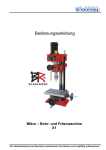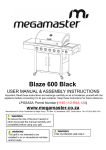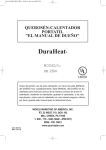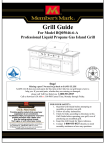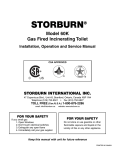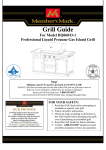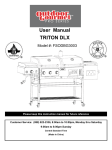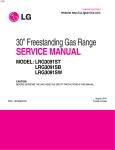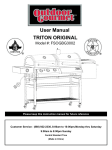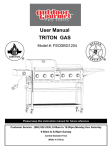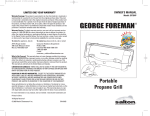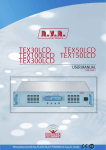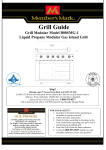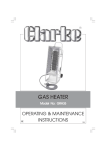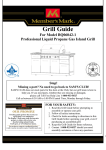Download Outdoor Gourmet CG3023E User's Manual
Transcript
Assembly Instructions LP Gas & Charcoal Grill Model # CG3023 CG3023E Please keep this instruction manual for future reference Customer Service: (888) 922-2336, 8:00am to 5:00pm, Central Standard Time, Monday thru Friday (Made in China) Warnings FOR YOUR SAFETY: 1.Read this Grill Guide before attempting to assemble or operate your grill. 2.Follow all safety instructions. 3.Check for leaks according to directions in this Grill Guide before operating your grill, even if you purchased this grill assembled. 4.Keep this Grill Guide for future reference. 5.Contact 1-888-922-2336 should you need assembly assistance or have any questions. THIS GRILL IS FOR OUTDOOR USE ONLY. If stored indoors, then detach and leave propane cylinder outside. TO THE INSTALLER OR PERSON ASSEMBLING THIS GRILL: Leave this Grill Guide with the consumer. TO THE CONSUMER: Retain this Grill Guide for future reference. 2 Warnings Safety Precautions Always read and follow all DANGER, WARNING, AND FOR YOUR SAFETY notices in this Grill Guide. Failure to follow these notices may result in property damage, bodily injury, or death. 1. Grill installation must conform with local codes, or in their absence, with either the National Fuel Gas Code, ANSI Z223.1/NFPA 54, Natural Gas and Propane Installation Code, CSA B149.1, or Propane Storage and Handling Code, B149.2. 2. This gas grill, when installed, must be electrically grounded in accordance with local codes, or, in the absence of local codes, with the National Electrical Code, ANSI Z21.58-2007, or the Canadian Electrical Code, CSA 1.6-2007. 3. This gas grill is intended for outdoor use only, and should not be used in a building, garage, or any other enclosed area. 4. This gas grill is not intended to be installed in or on recreational vehicles and/or boats. 5. Never use any other type of fuel for this grill other than LP gas (propane). 6. Only use the pressure regulator with a type 1 connector that is supplied with this gas grill 7. Before each use, check the gas hose for excessive abrasion, cracking, fraying, wear, or cuts. Replace a hose assembly showing those signs with the hose assembly specified in the parts list before using the grill. 8. Always perform a Leak Test before operating your grill. ! WARNING 1. Do not store or use gasoline or other flammable vapors and liquids in the vicinity of this or any other appliance. 2. An LP cylinder not connected for use should not be stored in the vicinity of this or any other appliance. ! DANGER If you smell gas: 1. Shut off gas to the appliance. 2. Extinguish any open flame. 3. Open lid. 4. If odor continues, keep away from appliance and call your local fire department. 3 Table of Contents • • • • • Tools and Parts Hardware Assembly Instructions Care and Maintenance Warranty Information 4 Tools Required 1 Description Adjustable wrench (not provided) 2 Description Screwdriver (not provided) 5 Parts List A Description Picture Qty B Description Picture Qty C Description Picture Qty D Description Picture Qty E Description Picture Qty F Description Picture Qty G Description picture Qty H Description Picture Qty 6 7 Hardware 8 Assembly Instructions Step 1: Assemble the two middle panels (16, 18) and four side panels (11,15, 27, 29). Make sure to assemble the two middle panels (16, 18) first. Assemble two middle panels using 8-M6x12 Bolts (B), and assemble side panels using 11-M6x12 Bolts(B) and 11-FLANGE LOCK NUTS (H). See the illustration below. Step 2: Assemble the ash pan (28) use BOLT M6x12 (B) fasten the ash pan and right middle panel. Then assemble the plug (51). See the illustration below. 9 Assembly Instructions Step 3: Attach the ash pan to the front and back panels using 4-BOLT M6x12 (B) and 4-M6 FLANGE LOCK NUTS (H). See the illustration below. Step 4: Turn over the grill body and assemble the left leg (38) and right leg (42) onto the body using 8-BOLT M6x12 (B) and 6-M6 FLANGE LOCK BUTS (H). Please do not tighten the screws at this time. 10 Assembly Instructions Step 5: Use BOLT M6x50 (F) to attach the bottom shelf (44) to legs, attach the highlighted in red legs first. Assemble the cylinder hanger (35) to the top of left leg (38) using 2-BOLT M6x12 (B), as shown in the picture below. Using 2-BOLT M6x50 (F) and 2-FLANGE LOCK NUTS (H) to assemble the gas tank holder (39) to the grill left leg (38) as shown below. DO NOT INSTALL THE CYLINDER AT THIS TIME Step 6: Place the axle (41) through the left leg (38) of the grill. Place the wheels (40) on the axle on the outside of the legs, attach the wheels with 2-washers (L) and 2-pins (I) on the outside of the wheels. Place the pins (I) through the hole in the axle outside of the washers. See illustration below. Attach the 2 Directional casters (45) to the bottom of the right leg (42). 11 Assembly Instructions Step 7: Attach the two triangular support braces (17, 26) connecting the legs to the back panel of the body using 8-BOLTS M6x12 (B). Step 8: Attach short fence rail 2pcs and long fence rail 2pcs to the four legs, using 8-BOLTS M6x12 (B) to fix. 12 Assembly Instructions Step 9: Assemble the accessories shelf (36) to the charcoal section of the grill using 4-BOLTS M6x12 (B). Step 10 10:: Attach the control panel (32) using 4-BOLT M6x12 (B), attach the knobs (33) as shown below. Attach the firebox bracket (30) to the right legs (42) using 2-BOLTS M6x60 (G) and 2-FLANGE LOCK NUTS (H). Tighten all connections at this time. 13 Assembly Instructions Step 11 11:: Attach the knob (33) and 4-BOLTS M6x12 (B) onto the body of side burner (12). Step 12 12:: Attach the side burner onto the body of the grill as shown below. 14 Assembly Instructions Step 13 13:: Take the Heat Shield (53) upon the Firebox Lid (22). Then attach the Handle(Firebox) (24),using Firebox Lid Handle Base(small)-2pcs(54) and 2-BOLT M6X25(C) . Then attach the Firebox Lid(22) upon the body of firebox(23),using Hinges(Body)(13) and 4-BOLT M6X35(D)and4-NUT M6 FLANGE LOCK(H) ,as shown below. Step 14 14:: Attach the side door handle (46) and air vent (48) onto the body of firebox using 2-BOLTS M6x12 (B) and 2-FLANGE LOCK NUTS (H). 15 Assembly Instructions Step 15 15:: Attach the hinges bottom (14) onto the back of the grill (total four pcs) using 4-BOLTS M6x40 (D). Attach the Firebox Handle(24) onto the firebox using Firebox lid handle base (54) and Bolt M6X25(C). See the illustration below. Step 16 16:: Attach 2-BOLTS M6x12 (B) into the body of firebox. NOTE: PLEASE DO NOT TIGHTEN THE BOLT NOW, AS SHOWN BELOW. 16 Assembly Instructions Step 17 17:: Attach the firebox to the main body of the grill, in the same manner that the side burner was attached in step 12. Using 4 additional BOLTS M6x12 (B), connect the firebox to the grill body from the inside of the grill body. Then use 2-NUT M6 FLANGE LOCK(H) to fixed. Once all bolts are in place and assembly of the firebox is complete, tighten all of the nuts and bolts. Step 18 18:: Place the cooking grid (25) and charcoal pan (47) into the body of the firebox. As shown below. 17 Assembly Instructions Step 19 19:: Using “R”PIN(I) and PIN Roll(K) to fixed the Hinges body(13) and bottom(14). As showen below. Step 20 20:: Attach 4-Hinges bottom to the grill body, using 8-BOLT M6X40(E) to fix. Then attach Extension Wire to the left side of grill body,using 1-BOLT M6X12(B) and 1-NUT M6 FLANGEL LOCK to fixed. As showen below. 18 Assembly Instructions Step 21 21:: Attach Hinges bottom(14) to the Lid Gas(5),using4- BOLT M6X40(E) and 4-NUT M6 FLANGEL LOCK(H) to fixed. Then attach 2-stack gas(3) to the lid gas(5),using 4-BOLT M6X20(B) and 4-NUT M6 FLANGEL LOCK(H) to fixed .Then attach the thermometer(4) to the lid gas(5).Last attach the lid handle (1) and lid handle base (2) to lid gas(5) ,using 2- BOLT M6X25(C) to fixed. Step 22 22:: Attach handle (1) and lid handle base (2) to lid gas(5) ,using 2- BOLT M6X25(C) to fixed. 19 Assembly Instructions Step 23 23:: Put the lid gas(5) and lid charcoal(6) upon the grill body . Using “R”PIN(I) and PIN Roll(K) to fixed the Hinges body(13) and bottom(14). Step 24 24:: Put the 3-burner(10) into the left side of grill body,then use BOLT M4X8 (A) to fixed. As showen below. 20 Assembly Instructions Step 25 25:: Put 3-Flame tamer into the left side of grill body. Attach the lifting handle(21) to the charcoal pan(20), then put them into the left side of grill body. Step 26 26:: Attach the 2-warming rack(19) to the lid and grill body. Then attach “R”PIN(J) to left side of lid gas(5). 21 Assembly Instructions Step 27 27:: Put 6-cooking grid(8) into the grill body. As showen below. Step 28 28:: Put receiving tray(37) under grease tray(34), then put them under the bottom of grill body. As showen below. 22 Assembly Instructions Step 29 29:: Attach the Regulator(31).Then put Grate hook (49) on the hook(50). Assemble the regulator by an adjustable Wrench Final Assembly 23 GAS GRILL Your new Outdoor Gourmet™ Grill has been designed and manufactured to high quality standards. It will provide you with many years of enjoyment with a minimal amount of maintenance. Please keep in mind the following FOR YOUR SAFETY. OPERATION 1. Your gas grill requires reasonable care during operation. It will be hot during cooking and cleaning. You should never leave the grill unattended or move the grill when in use. 2. Children should never use your gas grill. Keep younger children and pets away when in use. 3. Only use your gas grill outside in a well-ventilated area. Never use indoors in any building, garage, shed, or under any type of flammable canopy or overhang. 4. Ensure your grill is on level ground and the locking casters are locked before use. 5. Turn all gas valves off should the burners go out when cooking. Open the lid and wait 5 minutes before relighting. 6. Do not lean over the grill or touch the edges of the firebox or lid when in use. 7. Turn the burners off, close the lid, and shut off the LP cylinder should a grease fire occur. 8. Do not obstruct the flow of combustion and ventilation air to this grill. 9. Keep the outdoor cooking gas appliance area clear and free from combustible materials, gasoline, and other flammable vapors and liquids. 10. Keep the ventilation openings of the cylinder enclosure free and clear from debris. 11. Do not put a barbecue cover or other flammable material in the storage area of this grill. 12. Do not use charcoal briquettes, lava rock, or any type of ceramic product in the gas section of this grill. 13. Do not install or use on or in a recreational vehicle and/or boats. LP Gas and Cylinder Information Your new gas grill operates on LP (Liquid Petroleum) Gas. It is odorless, colorless, and non-toxic when produced. You can smell LP gas as it has been given an odor similar to rotten cabbage for your safety. Triangular Hand Wheel Your grill uses the newest and safest LP Gas Cylinder. 1. O.P.D. (Overfill Protection Device) – prevents accidental gas leaks caused by overfilling of the tank. Each tank contains a float that closes the input valve when the tank is 80% full. This allows room for the LP gas to expand in hot temperatures. A triangular hand wheel distinguishes this type of tank. 2. O.C.C.1 Type 1 Quick Connect Valve – provides fast tank hook-ups and requires only to be tightened by hand. In addition, the LP tank you use with your grill must meet the following requirements 1. Required Measurements: 12-1/2” (317mm) in diameter and 18-1/2” (472mm) in height. 2. 20-pound (9.1kg) propane cylinder. 3. Constructed and marked with U.S. Department of Transportation (D.O.T.) for the US or CAN/CSAB339, Cylinders, Spheres and Tubes for Transportation of Dangerous Goods; and Commission, for Canada. 4. A safety release valve. 5. A means for vapor withdrawal. ! WARNING 1. Do not attempt to use a cylinder with any other type of connection device. 2. Do not attempt to use a cylinder with a larger capacity 24 LP CYLINDER FILLING AND EXCHANGE Some areas only allow you to exchange your empty cylinder for a replacement that is already full. Other areas allow you to refill your cylinder. If you are in an area where you can refill your cylinder: 1. Use only a licensed dealer. 2. The dealer must first purge the cylinder before filling. 3. Never fill a cylinder more than 80% full by volume. Volume will vary by temperature. An empty cylinder weighs approximately 18 pounds (8.2kgs). A full one approximately 38 pounds (17.3kgs). 4. Be sure the LP dealer checks the cylinder for leaks after filling. 5. Do not release LP gas into the atmosphere, as it can unexpectedly ignite when mixed with air. 6. Contact a LP dealer to remove LP gas from a cylinder. 7. Only exchange your cylinder for one with an O.P.D. feature as shown on previous page. ! WARNING A frosty cylinder valve indicates possible gas overfill. Close the LP valve and call your dealer immediately. ! WARNING 1. Never store any extra cylinders near your grill. 2. Keep cylinders out of direct sunlight and high heat. 3. Never fill your cylinder over 80% full by volume. This may cause release of gas from the safety release valve. 4. Immediately call your LP dealer or fire department should you hear, smell, or see escaping gas from the cylinder. 5. Do not insert any type of foreign objects into the valve outlet. ! WARNING 1. The gas supply must be turned off at the LP-gas supply cylinder when this outdoor cooking gas appliance is not in use. 2. Storage of this gas grill indoors is permissible only if the cylinder is disconnected and removed from the gas grill. 3. Cylinders must be stored outdoors out of reach of children and must not be stored in a building, garage, or any other enclosed area. LP CYLINDER LEAK TEST A leak test should be done each time a cylinder is refilled or exchanged. Do not smoke or use any type of flammable material in the area during this leak test. Do not use an open flame to check for leaks. 1. Test outside in a well ventilated area. 2. Use a paintbrush and a solution of 50% liquid soap and 50% water. Do not use cleaning agents and they can damage the fuel supply parts. 3. Brush liquid onto areas highlighted with arrows. 4. Growing bubbles indicate a leak. ! DANGER Growing bubbles indicate a leak. In that case, call your LP dealer or fire department immediately. 25 TRANSPORTATION AND STORAGE 1. Always use the Safety Cap when transporting or storing your cylinder. 2. Do not store in a building, garage, or other enclosed area. 3. Always store your cylinder outside. 4. Store out of reach of children. 5. Always transport in an upright position. 6. Do not smoke when transporting your cylinder. Dust Cap Regulator and LP Cylinder Connections ! CAUTION The gas pressure regulator provided with this outdoor cooking appliance must be used. This regulator is set for an outlet pressure of 11 inches water column. Your regulator is equipped with a Q.C.C. Type 1 quick connect system. It will not allow gas to flow until a positive seal has been made. It has a thermal element that will shut off the gas flow if the temperature reaches 240 degrees F (115 degrees C). It also has a flow-limiting device that will restrict the flow of gas to 10 cubic feet per hour (0.28 cubic meters per hour). Before each use, check the gas hose for excessive abrasion or wear, or cuts. Replace a hose assembly showing those signs with the hose assembly specified in the parts list before using the grill. Gas Valve Manifold Assembly TO CONNECT THE CYLINDER TO THE REGULATOR AND HOSE 1. Be sure the LP cylinder is “OFF” by turning the hand wheel clockwise until it stops. 2. Place the cylinder on the hook beside of body with the valve facing outward. See Assembly Instructions to secure. 3. Be sure all burner controls are turned to the “Off” position. 4. Remove the safety cap from the from the cylinder valve. 5. Center the nipple of the regulator into the cylinder valve 6. Turn the black nut clockwise until it stops. Hand Tighten Only. Do Not Use A Wrench. 26 The regulator must enter the cylinder valve in a straight line. Center this nipple of the regulator into the cylinder valve. Q.C.C.1 Type 1 Connector ! WARNING Always keep the gas cylinder in the upright position at all times ! WARNING 1. Do not connect this grill to any unregulated sources of propane. 2. Before each use, check the gas hose for excessive abrasion or wear, or cuts. Replace a hose assembly showing those signs with the hose assembly specified in the parts list before using the grill. Inspect the hose assembly by opening the cabinet door underneath the side burner and following the regulator hose up to its connection to the gas manifold assembly. 3. Always perform the Leak Test listed below before using your grill for the first time, if the cylinder has been changed, any gas components have been changed, the regulator flow-limiting device has been activated, or after a long period of non-use. 4. Do not attempt to connect this grill to the LP system of a motor home or trailer. LEAK TESTING THE REGULATOR, VALVES, HOSES, AND CONNECTIONS 1. Ensure the LP cylinder valve and all burners are “Off”. 2. Ensure the LP cylinder is connected to the regulator. 3. If the information in1 & 2 is not followed exactly, a fire causing death or serious injury may occur. 4. Mix up a solution of 50% water and 50% liquid dish soap. Do not use any household cleaner solution. 5. Open the LP tank valve by turning the hand wheel counterclockwise one turn. If you hear a rushing sound, turn the gas off immediately. In that case, there could be a leak at the connection. Reconnect the cylinder to the regulator. 6. Spray or brush on the solution covering the following areas: cylinder welds, regulator and cylinder connection, gas hose connections to the regulator, all gas hoses, all gas hose connections to the burners including the main and side burners. 7. Growing bubbles on any of the parts and connections listed above indicate a gas leak. Immediately shut off the LP tank valve by turning the valve clockwise. Retighten the connections or order replacement parts as needed. Continue to test as necessary until no leaks are detected. 8. Close the LP tank valve by turning the hand wheel clockwise. ! WARNING 1. DO NOT USE THE GRILL if you cannot stop the leaks. Be sure the LP cylinder valve is closed. If the LP cylinder is still leaking, contact your LP dealer or local fire department. 2. Do not use any match or open flame, or smoke, during leak testing. 3. Do not light a burner during leak testing. 4. The replacement hose assembly must be the one identified. Grill Placement 27 ! FOR YOUR SAFETY 1. Minimum clearance from sides and back of unit to adjacent combustible construction below top of unit, 24 inches (60 cm) from sides and 24 inches (60 cm) from back. 2. Do not locate this outdoor cooking gas appliance under overhead-unprotected combustible surfaces. APARTMENT RESIDENTS Check with your apartment manager regarding your regulations for barbecues. ! WARNING 1. Do not use this grill in any enclosed area, garage, shed, or under any type of overhead structure or canopy. 2. Operate this grill only in a wellventilated area. Keep any electrical supply cord and the fuel supply hose away from any heated surfaces and water. Do not face the grill directly into the wind. Grill Operations LIGHTING Always visually inspect your grill before lighting. Replace any hoses that are frayed or cracked before lighting your grill. Look for anything that may be blocking spaces for ventilation and remove. After lighting, always check the flame to ensure you have a good flame all along each burner. If not able to light, or the flame is not even along the entire burner(s), then see the Trouble Shooting section ! WARNING 1. Read instructions before lighting. 2. Open lid during lighting. 3. If ignition does not occur in 5 seconds, turn the burner control(s) off, wait 5 minutes and repeat the lighting procedure 28 LIGHTING THE MAIN BURNERS USING ELECTRONIC IGNITION Main Burner 1. Open the lid. 2. Ensure all burner control knobs are in the “Off” position. 3. Turn on the LP gas by turning the hand wheel on the cylinder valve. 4. Turn one burner control knob marked with an igniter flame “ ” to “High”. 5. Depress the electronic ignition button and hold down. You should hear a Igniter Electric Lgniter clicking sound, which shows the electronic ignition is working. 6. If the burner does not light within 5 seconds, turn the burner control knob to “Off”. Wait 5 minutes for the gas to clear, and repeat the above procedure. Use the Manual directions if it still will not light. 7. When lit, turn the control knob to the desired setting. 8. Your grill is equipped with continuous ignition. Simply turn the control knob of the burner next to the lit burner to HI. It will light automatically. Do not press the electronic ignition button again. Then adjust control knob(s) to desired settings. MANUALLY LIGHTING THE MAIN BURNERS WITH THE MATCH LIGHTING STICK 1. Open the lid. 2. Ensure all burners are in the “Off” position. 3. Slowly turn on the gas at the LP tank valve if it is not already on. 4. Place a match in the Match Holder. This is located in the top center drawer of the grill cabinet underneath the right main burner. 5. Use the holder to slide the lit match though the cooking grates and the front of the heat tent to the left of the burner you wish to light. 6. Press and turn the burner control knob to “HI/LIGHT”. Continue to push in and hold up to 5 seconds or until the burner lights. 7. If the burner does not light within 5 seconds, turn the burner control knob to “Off”. Wait 5 minutes for gas to clear, and try again. 8. When lit, turn the control knob to the desired heat setting. LIGHTING THE SIDE BURNER WITH ELECTRONIC IGNITION 1. Open the side burner cover 2. Ensure the side burner control knob is in the “Off” position, as well as any main burners not in use. 3. Turn on the LP gas if it is not already on. 4. Turn the side burner control knob to “High”. 5. Depress the electronic ignition button and hold. You should hear a clicking sound, which shows the electronic ignition is working. 6. If the burner does not light within 5 seconds, turn the burner control knob to “Off”. Wait 5 minutes for the gas to clear, and repeat the above procedure. Use the Manual directions if it still will not light. 7. When lit, turn the side burner control knob to its desired setting. LIGHTING THE SIDE BURNER WITH THE MATCH LIGHTING STICK 1. Open the lid or side burner cover. 2. Ensure the side control knobs are in the “Off” position as well as any main burner not in use. 3. Turn on the LP gas if it is not already on. 4. Strike the match, and place near the top of the burner. 5. Turn the side burner control knob to “HIGH”. 6. If the burner does not light within 5 seconds, turn the burner control knob to “Off”. Wait 5 minutes for the gas to clear, and try again. 7. When lit, turn the burner control knobs to their desired setting. 29 TURNING OFF YOUR GRILL 1. Turn off the gas supply at the LP tank by turning the valve clockwise. 2. Turn all burner control knobs to the “Off” position. Cleaning Your Grill ! WARNING 1. Do not clean any part of your barbecue grill in a self-cleaning oven. 2. Do not use oven cleaners, abrasive kitchen cleaners, cleaners that contain citrus products, or mineral spirits. 3. Do not use any type of steel bristled brush. 4. Clean your grill regularly to prohibit grease build-ups and avoid a grease fire or excessive flare-ups. 5. Always allow the grill to cool down prior to cleaning. STAINLESS STEEL – clean with multipurpose low abrasive non-phosphorous metal or stainless steel polish and a soft cloth. Always polish in the direction of the lines. Do not allow grease and dirt to accumulate. In addition, the following products and naturally occurring substances in the outdoors will damage all stainless steel finishes. Use caution so that they do not come in contact with your Gas Grill. Immediately wash them off and dry the stainless steel should they ever come in contact with your Gas Grill. This includes, but is not limited to, Pool Chemicals (chlorine and bromine), Lawn Fertilizer, Ice Melting Salts, Sea or Salt Water, Urine, Bird Droppings, and Tree Sap. OTHER EXTERIOR SURFACES– wash with a mild dish soap and warm water. A cloth, soft brush, or plastic cleaning pad can be used. Rinse thoroughly and wipe dry. COOKING GRATES, WARMING RACK, AND HEAT DIFFUSERS – use a stiff brass brush. Wash with warm water and mild dish soap as needed, rinse, and dry. GREASE PAN AND TRAY – check after each use. Remove and empty the Tray when half full. Remove and clean the Pan as grease builds up. Both can be washed with warm water and mild dish soap. ELECTRONIC IGNITER – visually inspect for cracks. Replace if a crack is found. Do not use water to clean the igniter. BURNERS – we recommend you clean your burners at least twice a year, or before use if the grill has not been used in over one month. ! WARNING Small insects, such as spiders, are able to access the burner tubes. Sometimes they will build nests or spin webs. In either case, this can block or reduce the amount of gas flowing through the burner. You will usually see a smaller flame, or a flame that is mostly yellow rather than blue, coming from the burner when this happens. Other signs include the gill not heating evenly, not reaching temperature, or burners not igniting. In cases with severe blockage, this can cause the flame to burn backwards, and outside of the burner tubes, which can cause damage to your grill and/or personal injury. IMMEDIATELY SHUT OFF THE FLOW OF LP GAS AT THE CYLINDER BY TURNING THE HAND WHEEL CLOCKWISE SHOULD THIS HAPPEN. Wait for the grill to cool, and then clean all burners. 30 CLEANING THE BURNERS 1. Ensure the LP gas is turned off at the LP cylinder. 2. Remove the cooking grates, flame tamer, and grease tray. 3. Remove the cotter pins located underneath the back end of each burner. 4. Lift each burner up and out. 5. Clean the inside of the burner using a stiff wire. A straightened coat hanger is one suggested tool. An alternative way to clean the inside of the burner is using compressed air. Always wear eye protection if using this method. Never enlarge the burner ports during cleaning. 6. Brush the outer surface of the burner. 7. Ensure all ports (holes) are free of all debris 8. Inspect the burner. Replace if any cracks or enlarged holes. 9. Reinstall the burners making sure the burners seat over the valves as shown in the figure to the right. ! WARNING Properly locating the burner with respect to the orifice is vital for safety. 10. Secure the back of the burners to the firebox with the cotter pins. 11. Replace the grease tray, flame tamer, and cooking grates. 12. Perform a Leak Test described earlier in this guide. BURNER FLAMES Always inspect the burner flame after lighting. A good flame should be primarily blue with a yellow tip and have a minimal amount of noise. Some yellow tips are OK if under one inch. New burners sometimes have oil residue, which will cause yellow flame when burning off. Variations in gas supply, altitude, weather, and other factors can all impact burner performance. Older grills can also show more yellow flame as food deposits, oils, and fats can build up. ALWAYS 1. Keep the grilling area clear and free from combustible materials, gasoline and other flammable vapors and liquids. 2. Do not obstruct the flow of combustion and ventilation air. 3. Keep the ventilation openings of the cylinder enclosure free and clear from debris. ELECTRONIC IGNITION MAINTENANCE Your grill is equipped with electronic ignition. It’s powered by one “AA” size battery. Replace the battery when necessary. Unscrew the igniter top. Place the new battery into the igniter with the positive (+) end of the battery facing up. Screw the igniter top back into place. GRILL STORAGE 1. Clean your grill before storage. 2. Storage of a gas grill indoors is permissible only if the cylinder is disconnected and removed from the gas grill. 3. Cover the grill. 4. Perform a Leak Test before use after storage. 31 Grilling With Your New Grill Welcome to the world of grilling. Whether you’re already an established griller, or just starting out, your new grill should bring you much enjoyment and satisfaction, to say nothing of some phenomenal meals. We encourage you to experiment to find your own favorite recipes. The control panel is labeled “HI/LIGHT”, “LOW”, and “OFF” for each burner control knob. Simply push in on the temperature control knobs and turn to the desired heat setting. A thermometer is placed in the hood so that you can see the cooking temperature inside the grill. The heat diffusers are designed to help evenly distribute heat throughout the grill. They are also designed to catch and smoke the right amount of drippings, adding more flavors to your meal. DIRECT VS. INDIRECT COOKING Food cooked on the grill is either done using direct or indirect cooking. Direct cooking is when the food is cooked directly over the heat. Food is placed in-between the burners for indirect cooking. DIRECT – used for preheating and searing Use Direct cooking to sear meats. This helps to keep food moist by locking in juices. Some food, such as steak, is first seared using Direct cooking, and then finished cooking using the Indirect method. This is generally used for quicker cooking foods. Preheat the grill to 500°F (260°C). You can shut off one or more burners if you do not need to use the entire grilling surface once you reach over 500°F(260°C). You can also use a medium high heat of 400°F or more by turning the burners down slightly. Place the food directly over the heat source. Remain vigilant when grilling using this method, as it’s easy to overcook. INDIRECT – how most food is cooked on a gas grill Indirect cooking is used for foods that take longer to cook, including large cuts of meat such as roasts. It’s also used for cooking more delicate food that can dry out quickly such as fish and poultry, for fattier foods to reduce flare-ups, and when grilling using a roasting pan or aluminum foil. Preheat the grill to 500°F(260°C). Then turn some burners off, and others to medium to low depending on the temperature you want to maintain. Generally, turn the center burner off for a 3-burner model and the 2 inside burners off on a 4-burner model. Grills with more than 4 burners will vary depending on what you are cooking. Generally, you want to keep the temperature around 350°F. Do not place the food directly over any burners when using this grilling method. . SIDE BURNER Use the side burner to boil soups, corn on the cob, lobster, steam, stir-fries, or warm. GRILLING TIPS AND TRICKS 1. Always “Preheat” your grill before cooking. Light all main burners, turn to “HI”, and close the lid until the thermometer reads over 500°F (260°C), which should be 4 minutes. Then adjust the burner control knobs to the proper temperature. Note that no preheating is necessary for the side burner. 2. The thermometer measures the temperature at the top of the lid. The temperature down by the cooking grates is generally somewhat warmer. 3. Mother Nature can impact your grilling times. Allow more cooking time for cold, wind, and higher altitudes. We recommend you place the grill in an area protected from much wind. 4. Trim away any excess fat from meat to reduce flare-ups. 32 5. Keep similar size portions together so that they cook more evenly. 6. Generally speaking, the more food on the grill, the longer the cooking time. 7. Be aware when using the Direct cooking method, as food can easily become overcooked, burned, or dry out. Food may require more turning, or sometimes, may need to be moved off the flame. 8. Larger pieces of meat generally require more cooking time per pound than smaller pieces of meat. 9. If a major flare-up, or too many flare-ups occur, turn off the gas, move the food away from the flare-up, and close the hood. Restart the grill once the flare-up has died down. 10. Turn foods infrequently. Generally, only turn a steak once during cooking. 11. Use tongs rather than a fork when turning the food on the grill. Less juice will be lost that way. 12. Know your sauce and when to apply. Oil and vinegar based sauces can be brushed on any time. Sugar based sauces like barbecue sauce should be applied during the last few minutes of cooking. 13. A timer can help you keep from over-cooking the food. 14. Use insulated protective mitts or potholders when working around a grill in operation. 15. Use a small amount of cooking oil on the cooking grates before heating to reduce foods sticking on the grates. FOOD SAFETY 1. Always use safe food handling and preparation when using this grill. 2. Wash all poultry, seafood, and vegetables before cooking. 3. Use separate platters, plates, and utensils for uncooked and cooked foods. 4. Leave all meat, poultry, and seafood in the refrigerator until ready to cook. 5. Use a meat thermometer to ensure foods are adequately cooked. Trouble Shooting Guide BURNER WILL NOT LIGHT 1.) Gas supply is turned off. Turn on gas at LP tank. 2.) Out of propane. Check to be sure you still have propane in your tank. 3.) Regulator is not properly seated into the tank valve. Remove and reattach. Hand tighten only. 4.) Crimped fuel supply hose. Inspect and straighten. 5.) Regulator failure or damaged hose. Order replacement part and replace. 6.) Make sure you can hear the electronic igniter clicking. If not, replace the battery with an “AA” size. Inspect the electrode to be sure it’s not coated in grease or dirt. If so, clean with rubbing alcohol. Check the distance from the electrode tip to the burner. The tip of the electrode should be 1/8” to ¼” from the main burner and 1/8” to 3/16” from the side burner. Adjust if necessary. Inspect the electrodes to be sure they are not cracked or broken. If so, order replacement parts and replace. 7.) Blockage in the gas system. Inspect the burners to be sure insects, spider webs, etc do not block them. Clean if necessary. Inspect under the control panel to be sure the burners are aligned properly with the valves. IRREGULAR FLAME OR YELLOW FLAME 1.) New burner may have residual oil, which will burn off. 2.) Tubes in burners are blocked. Remove and clean. 3.) Burners have a high grease or dirt build-up. Remove and clean. 4.) Burners are not aligned properly with the valves. Inspect under the control panel. SUDDEN DROP IN GAS PRESSURE OR FLAMES BLOW OUT 1.) Out of gas. Check to be sure you still have propane in your tank. 33 2.) Your excessive fuel flow valve has tripped, thereby reducing the flow of gas. Turn off all burners, wait 30 seconds, and relight grill. If problem persists, turn off all burners. Disconnect regulator from tank. Wait 10 minutes. Reconnect regulator and leak test. Slowly turn on LP tank and relight grill. Other ways the flow limiting device can be activated include a. A ruptured gas hose. Inspect, perform a leak test, and replace as necessary. b. Opening the control knobs before turning on the LP gas at the tank. Turn on the gas at the LP tank first before turning on a control knob to light. c. Improper purging of tank before it was filled. See your LP gas dealer. 3.) Wind could be blowing out your burners. Turn front of grill to face wind or move out of the wind. EXCESSIVE FLARE-UPS 1.) Flame tamer, inside of grill, grates, and burners need to be cleaned. 2.) Grease tray needs to be cleaned and emptied. 3.) Using too high of heat to cook. Reduce control knob setting. 4.) Direct cooking method will produce more flare-ups than indirect. If using direct method, try using indirect. FIRE BEHIND CONTROL PANEL Immediately shut off LP tank valve and allow grill to cool. 1.) Check burners for obstructions and clean. 2.) Inspect under the control panel to be sure the burners are aligned properly with the valves. 3.) Gas is leaking from a faulty connection or damaged hose. Perform a leak test and inspect for leaks. Tighten or replace parts as necessary. 34 CHARCOAL SECTION AND SMOKER PREPATION FOR USE & LIGHTING INSTRUCTIONS Curing your grill Prior to your first use of the Grill, follow the instructions below carefully to cure your grill. Curing your grill will minimize damage to the exterior finish as well as rid the grill of paint odor that can impart unnatural flavors to the first meal prepared on the grill. IMPORTANT: To protect your grill from excessive rust, the unit must be properly cured and covered at all times when not in use. Step 1 Lightly coat all interior surfaces of the grill with vegetable oil or vegetable oil spray. Do not coat charcoal grates or charcoal ash tray. Step 2 Follow the instructions below carefully to build a fire. You may use charcoal and/or wood as fuel in the grill (see “Adding Charcoal/Wood During Cooking” section of this manual). If using a Charcoal Chimney Starter, follow all manufacturer’s warnings and instructions regarding the use of their product. Start with 5 pounds (2.3kg) of charcoal. This should be enough charcoal to cook with, once the curing process has been completed. When charcoal is burning strong, carefully place hot coals on charcoal grate. NOTE: To extend the life of your grill, make sure that hot coals and wood do not touch the walls of grill. IF USING CHARCOAL CHIMNEY STARTER, PROCEED TO STEP 5. If you choose to use charcoal lighting fluid, ONLY use charcoal lighting fluid approved for lighting charcoal. Do not use gasoline, kerosene, alcohol or other flammable material for lighting charcoal. Follow all manufacturer’s warnings and instructions regarding the use of their product. Start with 8 to 10 pounds (3.6 to 4.5 kg) of charcoal. This should be enough charcoal to cook with, once the curing process has been completed. Place the charcoal in the center of each charcoal grate. Step 3 Saturate charcoal with lighting fluid. With lid open, wait 2 to 3 minutes to allow lighting fluid to soak into charcoal. Store lighting fluid a safe distance from the grill. Step 4 With grill lid and doors open, stand back and carefully light charcoal through the doors. Allow to burn until covered with a light ash (approximately 20 minutes). Warning: Charcoal lighting fluid must be allowed to completely burn off prior to closing grill lid (approximately 20 minutes). Failure to do this could trap fumes from charcoal lighting fluid in opened. grill and may result in a flash-fire or explosion when lid is opened 35 Step 5 With coals burning strong, close the lid. Allow the temperature to reach 225°F (107°C) on temperature gauge. Maintain this temperature for 2 hours. Step 6 Increase the temperature to 400°F (205°C) on temperature gauge. This can be achieved by adding more charcoal and/or wood (see “Adding Charcoal/Wood During Cooking“ section of this manual). Maintain this temperature for 1 hour then allow unit to cool completely. NOTE: It is important that the exterior of the grill is not scraped or rubbed during the curing process. Adding Charcoal/Wood During Cooking Additional charcoal and/or wood may be required to maintain or increase cooking temperature. Step 1 Stand back and carefully open grill lid. Use caution since flames can flare-up when fresh air suddenly comes in contact with fire. Step 2 mitts/gloves, adjust the hanger so that the charcoal grate will be on the Wearing oven mitts/gloves lowest level of Grill Body. Use lifter to lift up the cooking grid and place it on a clean and surface. DO NOT touch the grid by hand. non-combustible surface Step 3 Stand back a safe distance and use long cooking tongs to lightly brush aside ashes on hot coals. Use cooking tongs to add charcoal and/or wood to charcoal grates, being careful not to stir-up ashes and sparks. If necessary, use your Charcoal Chimney Starter to light additional charcoal and/or wood and add to existing fire. ! WARNING ! Never add charcoal lighting fluid to hot or even warm coals as flashback may occur causing severe burns. Step 4 When charcoal is burning strong again, wear oven mitts/gloves and carefully return charcoal grates to Grill body with lifter. Extinguish any hot ashes, coals or embers which may have fallen from the grill or beneath and around grill. 36 AFTER-USE SAFETY ! WARNING ! � Always allow grill and all components to cool completely before handling. � unattended. Make sure coals and Never leave coals and ashes in grill unattended removing. ashes are completely extinguished before removing unattended, remaining coals and ashes must be Before grill can be left unattended removed from grill. Use caution to protect yourself and property. Place remaining coals and ashes in a non-combustible metal container and water. Allow coals and water to remain in metal completely saturate with water container 24 hours prior to disposing. � � Extinguished coals and ashes should be placed a safe distance from all structures and combustible materials materials. � With a garden hose, completely wet surface beneath and around the grill to extinguish any ashes, coals or embers which may have fallen during the cooking or cleaning process. Cover and store grill in a protected area away from children and pets pets. � Proper Care & Maintenance � Cure your grill periodically throughout the year to protect against excessive rust. � To protect your grill from excessive rust, the unit must be properly cured and covered at all times when not in use. � Wash cooking grills and charcoal grates with hot, soapy water, rinse well and dry. Lightly coat grills with vegetable oil or vegetable oil spray. � Clean inside and outside of grill by wiping off with a damp cloth. Apply a light coat of vegetable oil or vegetable oil spray to the interior surface to prevent rusting. Do not coat charcoal grates or charcoal ash tray. � If rust appears on the exterior surface of your grill, clean and buff the affected area with steel wool or fine grit emery cloth. Touch-up with a good quality high-temperature resistant paint. � Never apply paint to the interior surface. Rust spots on the interior surface can be buffed, cleaned, and then lightly coated with vegetable oil or vegetable oil spray to minimize rusting. 37 Frequently Asked Questions Can I convert my gas grill from one fuel source to another? No. Your gas grill is manufactured to specific standards developed by CSA and ANSI for your safety and grilling performance for either LP or Natural Gas. We do not offer conversion kits nor do we recommend you change the fuel type. How are your grills tested? Our grills are tested and certified by CSA, a leading worldwide independent testing center, to meet or exceed various CSA and ANSI standards along with various performance standards. The burners and gas line in each grill are also individually tested when each grill comes off the assembly line just prior to packaging. Each burner is ignited for this test. What is the humming noise I sometimes here coming from my regulator? The humming sound you can hear is just gas flowing through the regulator. There is no need to be concerned with a low volume of noise. My grill has a low flame on some burners, or some burners will not light at all. What can cause this? This can be caused by the regulator’s flow limiting device, which is generated by a sudden change in pressure. Opening the tank valve too quickly can cause this. In this case, close the LP tank valve and disconnect from the regulator. Let it stand for 10 minutes. Reconnect the regulator to the LP tank. Open the grill lid. Slowly open the LP tank valve. Follow the burner lighting procedures and light the burner furthest from the LP tank. Continue to light the other burners as you move towards the LP tank. Can I use ceramic plates, briquettes of any kind, or lava rocks? No. Your grill is designed for use only with the heat diffusers. Grease drips down on to the diffusers and is burned, creating steam and additional flavor. For technical support and replacement parts service Business hours: Monday through Friday; 8:30AM-5:00PM Central Time. For customer service please call 1-888-922-2336 or via e-mail at [email protected] Do not call store for technical support and replacement part. 38 1-888-922-2336 39







































